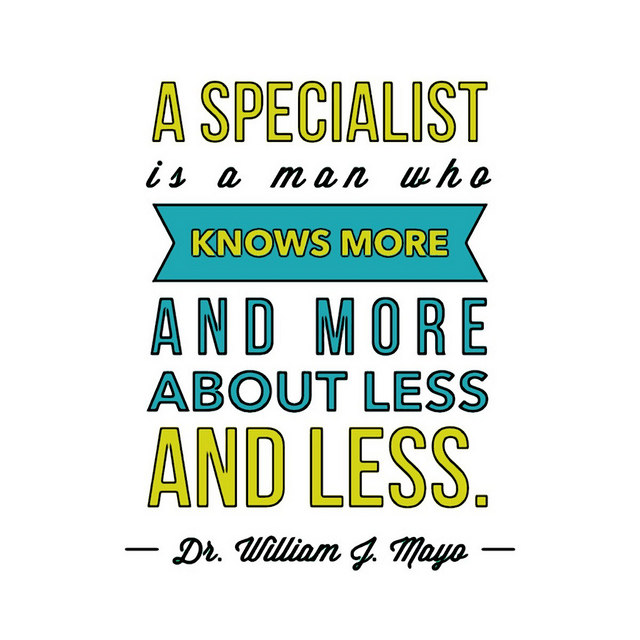The rise of the generalist

“We used to be defined by what we knew. But today, knowing too much can be a liability.”
—Peter Evans-Greenwood, How much do we need to know?
Once upon a time, I enjoyed a lucrative career as an independent IT consultant. For 20+ years, I turned down more work than I accepted. And I never advertised; all business came via word-of-mouth, from CEO to CEO.
There was plenty of competition, and yet most of my competitors struggled for work.
Want to know one of my secrets?
I was a generalist
My clients wanted their problems solved. There were three key reasons why they needed help:
- My clients did not know what their problems were. (Yes, this sounds strange, stay with me.)
- Their problems were complex, crossing traditional expertise boundaries.
- They thought their problems were technical issues, but there was invariably a critical people component.
When I started IT consulting, I thought companies would hire me because I had specialized technical skills they did not possess. Over time, I slowly realized that what made me valuable and useful to my clients were my abilities to:
- Uncover their real problems;
- Understand the entirety of what they needed to solve their actual problems;
- Diplomatically explore, explain, and convince clients of what they needed to do;
- Successfully work with them to devise and implement effective solutions; and
- Help them take ownership of the ongoing management of relevant issues so the problems didn’t reoccur.
The advantages of being a generalist
Today’s hard problems straddle traditional specialties. Being a generalist in the realm of consulting means being willing and able to see and act on a bigger picture than clients typically initially present. For example, no one ever hired me to solve “people problems”, but I can’t recall a consulting assignment where human issues weren’t an important factor. Some examples:
- A ten-year-old silent war between two department heads that had never been addressed;
- The internal IT staffer who was crippling company growth because he knew far less than he claimed;
- A CEO who hired a golf buddy to recommend that an appropriate and functional information system be replaced;
- The operations manager who routinely made decisions without the authority to do so.
My successful IT consulting career combined adequate technical knowledge, business managerial experience (from five years managing a solar manufacturing company), good problem-solving abilities, continuous acquisition of people skills, creativity, and a win-win mindset that focused on serving my clients rather than maximizing my income at their expense. During two decades of work, I saw many independent IT specialists who were, despite possessing technical knowledge superior to mine, unable to maintain a viable business.
I’m still a generalist
I’m still a consultant today, but in a different field—meeting design. And I’m still a generalist, because good meeting design requires knowledge and skills in many different areas: production, andragogy (how adults learn), facilitation, and people skills, to name a few.
We are living in a world where the commodification of products and skills leads more and more quickly to a race to the bottom—” Who can make/do this for the least amount of money/time?” (For example, accountancy, once seen as a secure well-paying profession, is increasingly outsourced and automated.) As a result, the advantages of the generalist mount because relatively few people have the required skill set to solve problems that cross traditional specialties, and it’s easier to thrive in a field with, say, ten competitors as opposed to ten thousand.
To summarize, here’s an apt quote from Peter Evans-Greenwood’s excellent article:
We’re moving from working in the system that is a business, to working on the system. The consequence of this is that its becoming more important to have the general capabilities and breadth of experience that enable us to develop and improve the system in novel directions, than it is to have deep, highly entailed experience in working within the current system. There will always be a need for narrowly focused expertise in highly technical areas, but in the majority of cases the generalist now has an advantage over the specialist.
Are you a specialist or a generalist? How’s that working out for you?
Photo attribution: Flickr user environmental_illness_network

 Ask, tell, ask.
Ask, tell, ask.


 A while back I posted a summary of
A while back I posted a summary of